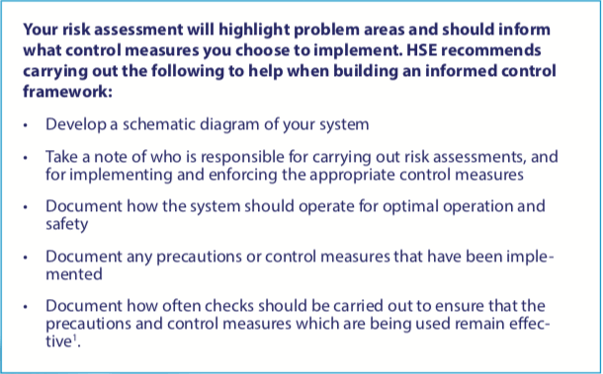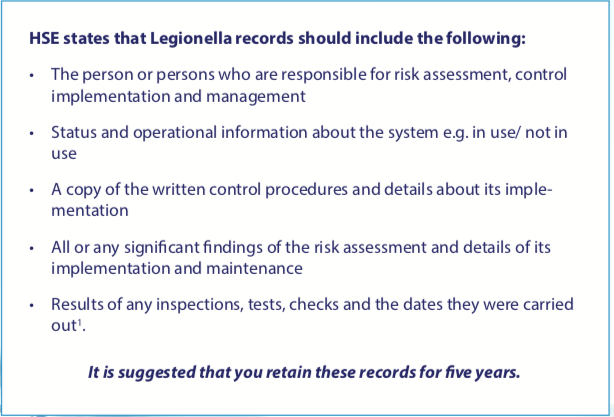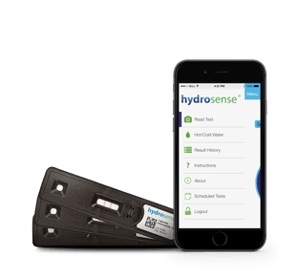
Legionella Risk Assessment- How to protect your business against Legionella?
In recent years, governments have been responding to rapid Legionella growth as a global health problem, with huge fines. Negligence surrounding the issue is no longer acceptable nor tolerated. Businesses that fail to control the risk of Legionella in their facilities are liable to be fined tens of thousands or even millions and in some serious cases, duty holders and business owners can face several years in prison on grounds of manslaughter.
Employers, landlords and responsible persons are accountable under several pieces of legislation to oversee, understand and control the risk of Legionella in their facility.
 In the UK, the Health and Safety at Work Act of 1974; the Management of Health and Safety Regulations and the Control of Substances Hazardous to Health Regulations of 2002, require responsible persons to take appropriate measures to reduce risk to employees and the general public.
In the UK, the Health and Safety at Work Act of 1974; the Management of Health and Safety Regulations and the Control of Substances Hazardous to Health Regulations of 2002, require responsible persons to take appropriate measures to reduce risk to employees and the general public.
In the EU as a whole, Directive 2000/54/EU of the Eu-  ropean Parliament and the Council, dated on the 18th
ropean Parliament and the Council, dated on the 18th
of September 2000, protects all EU workers from risk related to exposure to biological agents at their place
of work. Legionella is a group 2 pathogen and EU legislation demands that an employer carry out appropriate risk assessments and take measures to protect their staff at work2.

In the US, ASHRAE 188 states that all facility operators should implement and enforce a water management program for any water system that could contain and spread Legionella, which is supported by CDC who advocates for appropriate maintenance of water systems and recommends a strategy for doing so4.
Appoint a Competent Responsible Person
Appointing a responsible person or persons is the first step any business owner or manager should take to reduce Legionella risk. The chosen individuals MUST understand how to identify, manage, prevent and control risk while also upholding proper records of their duties1. The responsible person can be yourself, one of your workers or someone from outside of your business, but remember, whoever you choose must be competent. The duty holder is responsible for the safety of your water, and even if you chose to outsource water management services to a third party, he/she must ensure that all contractors meet the required standards.
Risk Assessment
Once you have appointed your responsible person, you should start planning your risk assessment.

At this point, if the competent responsible person, or the competent third party is sure that the risk is low and that all controls are being properly managed and maintained, no further action may be needed. However, this assessment MUST be reviewed regularly.
How to Prevent and Manage Risk
The best way to prevent the growth of Legionella is through solid design planning, frequent maintenance checks and appropriate control schemes. Keeping pipework as short and direct as possible; adequately insulating pipes and tanks; using materials that do not encourage the growth of Legionella and preventing contamination by fitting tanks with lids and insect screens, are just a few examples, provided by HSE, that will improve the design of your water system and will reduce risk of bacterial growth1.

Keeping Records
Record keeping is the best way to build a timeline of data regarding the safety of your water system – by keeping up to date and thorough Legionella records you will not only be able to ensure that safety is being maintained and prove this in a court of law, but you will also be able to see emerging trends in water safety. This wealth of data can inform better decision making and improved control measures.


Recommended Controls
The primary method of Legionella control in any water system, as stated by HSE, is temperature control.
Hot water should always, where possible, be kept at temperatures of 60°C or above and distributed at temperatures of 50°C or above. It may also be necessary to fit thermostatic mixer valves to areas where a scald risk has been identified1. These high temperatures will in most cases kill off any Legionella present.
Cold water should always be stored and distributed below 20°C, to inhibit the growth of Legionella bacteria. However, Legionella has been found to survive in a dormant state at low temperatures and
reactive when temperatures rise again. For this reason, it is crucial that control measures are well monitored and that systems are regularly tested.

It is also worth de-scaling, cleaning and draining the water system where possible, to check for signs of corrosion. Removing areas of stagnation, by removing dead legs, and flushing out infrequently used outlets weekly, will help to reduce the risk of Legionella growth.

Water Treatment
In some water systems, the control of temperature can be difficult if not impossible for a number of suboptimal design reasons. However, there are other ways to control and treat Legionella in your water system; with copper and silver ionisation and biocide treatment for example. For these methods to be effective there must be proper installation, maintenance and monitoring of the overall water system and treatment programme.
Copper and Silver Ionisation: This method generates copper and silver ions and releases them through a current in the water system, distorting and weakening the Legionella cell walls and damaging supporting systems to the cell. This method is not corrosive to metal piping and in some cases, can actually help to plate and rejuvenate piping. This method, unlike chemical methods, does not gas off with distance in long or complex water systems, nor is it affected by high water temperatures, like chlorine dioxide and UV light systems.
Oxidizing Biocides: Halogens like chlorine, bromine and chlorine dioxide are all oxidizing biocides. They are rapid and effective in killing bacteria but can cause corrosion and react with other chemicals present in the system. These chemicals are also sensitive to pH and must be used in parallel with careful controls (pH range between 7-10 required). Chlorine-based formulas can also fail to penetrate biofilm, creating protection for any legionella inside5.
Chlorine dioxide is recommended over chlorine or bromine because it is more effective at higher temperatures, less corrosive and is less sensitive to pH (pH range between 4-10 required). It is also more effective for penetrating biofilms and is approved in many countries for potable water treatment.
Bromine is only moderately effective for killing Legionella bacteria and requires higher concentrations. It is more effective than chlorine at higher pH levels and is not as corrosive5.
Non-oxidizing Biocides: Organic compounds such as BNPD (2-bromo-2-nitro- propane-1, 3-diol), glutaraldehyde, dithiocarbamates, isothiazolin, DBNPA (di-bro- mo-nitrilo-propionamide), and some quaternary ammonium compounds are all non-oxidizaing biocides. These compounds are much slower and must be added to the system in doses – often weekly. Overdosing is normal, and the biocide level is then allowed to decrease until the next dose is added. This method can be more expensive, more toxic to both animals and humans, more dangerous to store and handle and particularly hard to dispose of due to environmental regulation5.
Alternating the use of biocides, the frequency of use and the level of dosage in your system can help to minimise the growth of resistant strains of bacteria and is necessary for a good biocide programme6.
Routine Testing
Routine testing is a crucial part of any successful risk management program. It is an important tool for keeping control measures, such as temperature and biocide levels, in check, for reducing risk to people’s health and for saving businesses from huge fines and reputational damage. HSE advises monthly checking for sentinel outlets, which lie closest and furthest away from water tanks and cylinders; monthly checks for hot storage systems and checks for cold water systems every six months1. If your system presents more risk, due to age or complexity, or if there are vulnerable persons present in your facility, consider testing more frequently.

In the past, lab culture was the only testing method available to responsible persons and water management specialists. However, the method has been widely criticized for its slow time to result, low accuracy of only >65%7 and inability to detect Viable but Non-Cultural Bacteria8. However, new innovative testing methods are now making their way onto the market and can provide a more timely, simple and easy to use solutions for minimising risk and checking controls.
The Hydrosense antigen test, for example, is highly sensitive, can be done on-site and provides a clear call to action for the strain of Legionella which has caused almost all outbreaks of Legionnaires’ disease to date9.
For more guidance please see:
References:
1 Hse.gov.uk. (n.d.). [online] Available at: http://bit.ly/2mfHhFo [Accessed 22 Jun. 2018].
2 Osha.europa.eu. (2011). [online] Available at: http://bit.ly/2ksBCvm [Accessed 22 Jun. 2018].
3 Ashrae.org. (2015). [online] Available at: http://bit.ly/2kQpdBu [Accessed 22 Jun. 2018].
4 Besser RE. (2002). In: Marre R et al, eds. Legionella. Washington, D.C.: American Society for Microbiology, 391-397
5 Public Services and Procurement Canada. (2018). Appendix B. Available at: http://bit.ly/2lZKTeQ [Accessed 22 Jun. 2018].
6 Public Services and Procurement Canada. (2018). Appendix A. Available at: http://bit.ly/2lZKTeQ [Accessed 22 Jun. 2018].
7 International Standards Organization. (2017). ISO-11731. Available at: http://bit.ly/2kqs97N [Accessed 22 Jun. 2018].
8 Alleron, L., Merlet, N., Lacombe, C. et al. (2008). Available at: http://bit.ly/2lVwtw4 [Accessed 22 Jun. 2018].
9 Mercante, J. and Winchell, J. (2015). Clinical Microbiology Reviews 28(1), pp.95-133. Available at: http://bit.ly/2moFWwl [Accessed 24 Jun. 2018]

